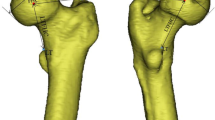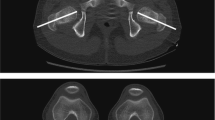Abstract
Purpose
The aim of this preliminary study was to determine the accuracy of CT-scan to locate the femoral head centre.
Methods
Eleven dried femurs were included for study. Three techniques were compared to determine femoral head centre (FHC) location: CT-scan, Motion Analysis and Faro-Arm. Markers were stuck on each femur to create a system of coordinates. Femurs lied on their posterior parts (bicondylar plane). Several points around the femoral head were palpated (Motion Analysis and Faro-Arm) or determined (Amira software for CT-scans). By a least-square regression method, the FHC location in 3D was defined for each technique.
Results
The results of the FHC location determined by the CT-scan technique were compared with those measured by the faro-arm and the Motion Analysis techniques. The coordinates (X, Y, Z) of the FHC were compared between the three methods, and no statistical difference was found (p = 0.99). In a 3D plot, this gave a mean difference of 1.3 mm. The mean radius of the femoral head was of 22.5 mm (p = 0.6).
Conclusions
CT-scan is as accurate and reliable as gold-standard techniques (motion and faro-arm). Locating FHC before and after hip arthroplasty would allow hip surgeons to determine and compare 3D orientation of the upper-end of femur: offset, height and anteversion.





Similar content being viewed by others
References
Ackland MK, Bourne WB, Uhthoff HK (1986) Anteversion of the acetabular cup. Measurement of angle after total hip replacement. J Bone Joint Surg Br 68(3):409–413
Amuwa C, Dorr LD (2008) The combined anteversion technique for acetabular component anteversion. J Arthroplast 23(7):1068–1070. doi:10.1016/j.arth.2008.04.025
Asayama I, Naito M, Fujisawa M, Kambe T (2002) Relationship between radiographic measurements of reconstructed hip joint position and the Trendelenburg sign. J Arthroplast 17(6):747–751
Bozic KJ, Kurtz SM, Lau E, Ong K, Vail TP, Berry DJ (2009) The epidemiology of revision total hip arthroplasty in the United States. J Bone Joint Surg Am 91(1):128–133. doi:10.2106/JBJS.H.00155
Fessy MH, Bejui J, Fischer LP, Bouchet A (1995) The upper end of the femur: dimensions of the endosteal canal. Surg Radiol Anat 17 (2):155–160, 121–153
Fessy MH, N’Diaye A, Carret JP, Fischer LP (1999) Locating the center of rotation of the hip. Surg Radiol Anat 21(4):247–250
Fessy MH, Seutin B, Bejui J (1997) Anatomical basis for the choice of the femoral implant in the total hip arthroplasty. Surg Radiol Anat 19(5):283–286
Haenle M, Mittelmeier W, Barbano R, Wörtler K, Scholz R, Bader R (2010) Accuracy and reliability of different methods to evaluate the acetabular cup version from plain radiographs. Surg Radiol Anat 32(8):5
Khatod M, Barber T, Paxton E, Namba R, Fithian D (2006) An analysis of the risk of hip dislocation with a contemporary total joint registry. Clin Orthop Relat Res 447:19–23. doi:10.1097/01.blo.0000218752.22613.78
Lazennec J-Y, Charlot N, Gorin M, Roger B, Arafati N, Bissery A, Saillant G (2004) Hip-spine relationship: a radio-anatomical study for optimization in acetabular cup positioning. Surg Radiol Anat 26(2):8
Learmonth ID, Young C, Rorabeck C (2007) The operation of the century: total hip replacement. Lancet 370(9597):1508–1519. doi:10.1016/S0140-6736(07)60457-7
Lecerf G, Fessy MH, Philippot R, Massin P, Giraud F, Flecher X, Girard J, Mertl P, Marchetti E, Stindel E (2009) Femoral offset: anatomical concept, definition, assessment, implications for preoperative templating and hip arthroplasty. Orthop Traumatol Surg Res 95(3):210–219. doi:10.1016/j.otsr.2009.03.010
Liaw CK, Hou SM, Yang RS, Wu TY, Fuh CS (2006) A new tool for measuring cup orientation in total hip arthroplasties from plain radiographs. Clin Orthop Relat Res 451:134–139. doi:10.1097/01.blo.0000223988.41776.fa
McCollum DE, Gray WJ (1990) Dislocation after total hip arthroplasty. Causes and prevention. Clin Orthop Relat Res 261:159–170
Murphy SB, Simon SR, Kijewski PK, Wilkinson RH, Griscom NT (1987) Femoral anteversion. J Bone Joint Surg Am 69(8):1169–1176
Murray DW (1993) The definition and measurement of acetabular orientation. J Bone Joint Surg Br 75(2):228–232
Noble PC, Sugano N, Johnston JD, Thompson MT, Conditt MA, Engh CA Sr, Mathis KB (2003) Computer simulation: how can it help the surgeon optimize implant position? Clin Orthop Relat Res 417:242–252. doi:10.1097/01.blo.0000096829.67494.dc
Pradhan R (1999) Planar anteversion of the acetabular cup as determined from plain anteroposterior radiographs. J Bone Joint Surg Br 81(3):431–435
Spalding TJ (1996) Effect of femoral offset on motion and abductor muscle strength after total hip arthroplasty. J Bone Joint Surg Br 78(6):997–998
Sugano N, Noble PC, Kamaric E (1998) A comparison of alternative methods of measuring femoral anteversion. J Comput Assist Tomogr 22(4):610–614
Tonnis D, Heinecke A (1999) Acetabular and femoral anteversion: relationship with osteoarthritis of the hip. J Bone Joint Surg Am 81(12):1747–1770
Conflict of interest
None.
Author information
Authors and Affiliations
Corresponding author
Rights and permissions
About this article
Cite this article
Viste, A., Trouillet, F., Testa, R. et al. An evaluation of CT-scan to locate the femoral head centre and its implication for hip surgeons. Surg Radiol Anat 36, 259–263 (2014). https://doi.org/10.1007/s00276-013-1172-7
Received:
Accepted:
Published:
Issue Date:
DOI: https://doi.org/10.1007/s00276-013-1172-7




